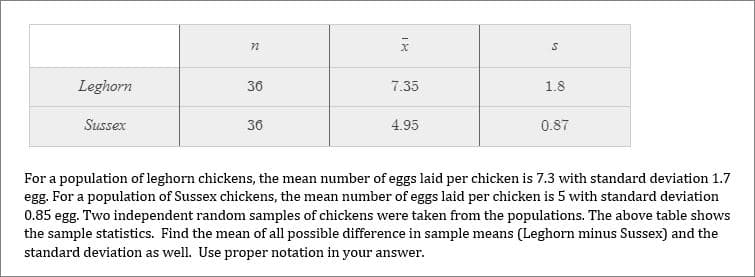For a population of leghorn chickens, the mean number of eggs laid per chicken is 7.3 with standard deviation 1.7 egg. For a population of Sussex chickens, the mean number of eggs laid per chicken is 5 with standard deviation 0.85 egg. Two independent random samples of chickens were taken from the populations. The above table shows
For a population of leghorn chickens, the mean number of eggs laid per chicken is 7.3 with standard deviation 1.7 egg. For a population of Sussex chickens, the mean number of eggs laid per chicken is 5 with standard deviation 0.85 egg. Two independent random samples of chickens were taken from the populations. The above table shows
Glencoe Algebra 1, Student Edition, 9780079039897, 0079039898, 2018
18th Edition
ISBN:9780079039897
Author:Carter
Publisher:Carter
Chapter10: Statistics
Section10.4: Distributions Of Data
Problem 19PFA
Related questions
Question

Transcribed Image Text:Leghorn
36
7.35
1.8
Sussex
36
4.95
0.87
For a population of leghorn chickens, the mean number of eggs laid per chicken is 7.3 with standard deviation 1.7
egg. For a population of Sussex chickens, the mean number of eggs laid per chicken is 5 with standard deviation
0.85 egg. Two independent random samples of chickens were taken from the populations. The above table shows
the sample statistics. Find the mean of all possible difference in sample means (Leghorn minus Sussex) and the
standard deviation as well. Use proper notation in your answer.
Expert Solution
This question has been solved!
Explore an expertly crafted, step-by-step solution for a thorough understanding of key concepts.
This is a popular solution!
Trending now
This is a popular solution!
Step by step
Solved in 2 steps

Recommended textbooks for you

Glencoe Algebra 1, Student Edition, 9780079039897…
Algebra
ISBN:
9780079039897
Author:
Carter
Publisher:
McGraw Hill

Glencoe Algebra 1, Student Edition, 9780079039897…
Algebra
ISBN:
9780079039897
Author:
Carter
Publisher:
McGraw Hill